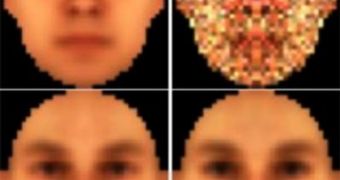Brown University researchers, scientist Michael J. Tarr, a Fox professor of ophthalmology and visual sciences and professor of cognitive and linguistic sciences at the University, and graduate student Adrian Nestor, discovered that men have more red pigment on their faces, whereas women tend to have more green. The discovery was made while analyzing some 100 photos of members of each gender, who were photographed in similar conditions, with no make-up.
"Color information is very robust and useful for telling a man from a woman. It's a demonstration that color can be useful in visual object recognition," Tarr explains. He adds that the idea that color could help us identify various classes of objects is a very disputed one, but that the new research could actually prove that light and color still play an important role in recognition.
He argues the possibility of using his find in state-of-the-art facial recognition pieces of software that could add further criteria to the already-existing one, such as fingerprints, height, eye color, retina make-up, etc. "If it is on the more red end of the spectrum (the face) had a higher probability of being male. Conversely, if it is on the green end of the spectrum (the face) had a higher probability of being female," the research says.
In another part of his study, Tarr used a technique to blur images of various pictures of men and women, and then made them either greenish or reddish, although a strict gender association was not preserved. Three volunteers, with no color blindness issues, were asked to partake in the study and were shown these pictures, while asked to select which was male and which was female.
Analysis of the results revealed that the actual gender of the person in the image counted very little when it came to selection. The participants selected redder faces for those of males, and greener faces for those of females, even though, once the images were cleansed from their blur, genders were mixed altogether.
This sheds some light on the way our unconscious mind records and interprets data coming from other people. Tarr says that further studies in the area of bodily light emissions could offer even more insight into how our brain perceives color and the associations it relates to it afterwards.

 14 DAY TRIAL //
14 DAY TRIAL //